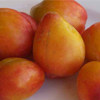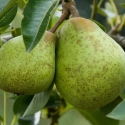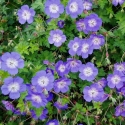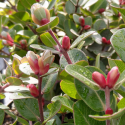Friday 6th March, 2020
Hi
Will the next project please show it'self!
February is that time of year when we get to do all our other stuff. You know, all that maintenance stuff that sets us aside. Fences and tables repainted and looking fresh and black. Wet spots in the nursery, where water keeps pooling under the plants and looking very messy, have had the weed cloth lifted and new metal placed underneath and the cloth relaid. Torn weed cloth throughout the nursery has been replaced and refreshed. We have even had time to pull the potting bench right out, re level the ground underneath and then again put down new weed mat, no more standing in water this coming potting season for us! Even painted the potting bin and it looks awesome and with a fresh new lease on life.
But it's not just all about the outside team, the admin team have projects as well, you are reading one that was just completed, this new look email that we send out each week. We even have a new signature on the tail of our emails. Still thought there is a bigger fish to fry... being an upgrade of the website... we are not changing anything important but perhaps giving it a face lift ... watch this space . But wait... there's more... I have been given a list of Topics for our How To page and this weeks topic is about setting up your own orchard!
Setting up a home orchard
We often get asked about about this and I guess that it all depend on how much space you have for planting trees and whether you are after a conventional kind of layout, being rows of trees.
First up its worth considering the area that you propose to plant. Fruit trees, in general, will all need reasonably fertile soil, full sun and access to adequate moisture. A good open position with adequate air movement, though some shelter from excessive winds is important. Next consideration is how you want to lay the trees out and whether you need a path between them. I have 18 pip and stone fruit trees in my orchard and I have allowed enough space for them to grow to 3-4 metres, including a ride on lawn mower space between them in a typical grid pattern. You can create any layout that suits your space when taking into account the size the trees will grow and how you want to maintain in between them.
A commercial orchard usually consist of a mono crop (just one fruit type) eg apples and would be set up in rows with widths between to suit machinery and maximise space for return which is quite different from the home garden situation where I guess most will want one of everything.
One of everything can be a bit tricky as they all grow differently. I usually look at the selection of trees that some choose and then think about the mature dimensions of the trees. It is also worth thinking about whether the trees fruit on fruiting spurs or previous seasons wood.
Plums,
Peaches,
Nectarines and
Cherries, for example, fruit on previous seasons wood and can be more challenging to keep small and will probably mature out after 3 to 4 years to around 3 to 4 metres. Though technically could be kept smaller with the correct pruning. Remember that some fruit trees may need a pollinator so that can affect your choices.
Apples and
Pears fruit on fruiting spurs so they could be kept smaller or allowed to grow bigger to match stone fruit. Of course these can be espaliered, cordoned or some other fancy, the moral really is... keep the bigger trees together and then perhaps have a different layout for a smaller selection.
Citrus are different again with different types having height variations... grapefruit, oranges, Lisbon lemons and some mandarins grow 3 to 4 metres while Satsuma mandarins, Meyer lemons and limes are that much smaller, growing to a more demure 2... ish metres.
Blueberries,
raspberries, grapes and
Boysenberries have either shrub or climber habits and the like, whilst they may be part of your orchard, they have different needs and structure than, the likes of, the tree like specimens, again the layout should be part of your design with consideration on how you are going keep it weed free.
My home orchard top tips
Make an orchard map so you know what you have, note the variety, how to prune it, what its needs are and if you need extra advice.
Good air movement through the orchard and around trees will help reduce pest and disease... though excessive winds, like prevailing, can cause other problems.. so provide shelter from excessive winds.
Full sun position... Fruit trees like full sun and will do their best out in the open. Plenty of sun equals plenty of photosynthesis so plenty of food to grow the best crops.
Well fed plants are more healthy so mulch circles around the trees will help condition the soil by encouraging soil organisms. It also helps with water retention and provides space to feed with fertilisers, more organic matter etc and watering.
Stake new trees so that they establish well and do good formative pruning from day one so that you establish a good framework. it will take about three years.
Plan and order now
Now is the time to plan your orchard. Set aside the space and perhaps even organise the planting spaces.. dig compost in now so it is well decomposed and blended in time for planting new season trees.
If there is stock of your choice available then Autumn is a great planting time.
If your choice of fruit trees are not currently available then chances are they will be in July. It's always a good idea, once you know what varieties you are wanting in your orchard, to place an order for them now so that you don't have to compromises on varieties when they arrive. You can back order your requirements and we will send you an email when they become available.
Hydrangeas of the paniculata form
There are a few differing species of Hydrangea and of late there have been three or four new cultivars of the
paniculata species, which in my opinion are pretty gorgeous. Typically they have classic hydrangea individual flowers, held as one large bloom, but in a cone shape, rather than the
mophead shape of the species that we all know so well. The flowers also are initially only shades of cream or white rather than blues and pinks of the macrophylla species. As with most hydrangeas the flowers age or antique on the plant into some gorgeous colours but the paniculata fame is that they age into very pretty shades of pink.
A cool point about Hydrangea paniculata hybrids is that they flower on new seasons wood, unlike the other species. This means that you can cut them back quite hard in the winter and they will grow and flower in the spring regardless. The paniculatas can also grow larger in form and are more sunlight tolerant, though will still enjoy dappled light.
Sundae Fraise is exceptional for its smaller proportions. It grows well and has a very bushy, semi-upright, well balanced low growth. The red brown stems bear perfect, medium sized panicles. The abundant green and white sterile flowers quickly turn the pink shade of a sundae fraise... translates in French as Strawberry dessert in a glass.
Diamond Rouge. This brilliant Hydrangea is the reddest of all Hydrangea paniculata varieties. During early summer it unfurls very large heads of white flowers. These flowers gradually turn pink and as summer moves into autumn a spectacular purple, shaded red. Like Sundae Fraise it is quite dwarf growing only 120 cm tall.
Limelight is one of my favourites. This award winning Hydrangea has large, soft, conical flower heads that put on a
magnificent display in summer-autumn. The flowers open to a fresh shade of chartreuse, then gradually turn cream and finally become a deep smoky shade of pink.
Candlelight is an upright, hardy, stylish, deciduous shrub with creamy white blooms on deep red stems. As the blooms mature the petals get a light blush of pale pink. It develops sturdy, upright, dark red twigs that don't droop.
Levana is one of the bigger varieties at a mature height of around 3m. This gorgeous hydrangea has huge, conical, panicles of white bloom up to half a metre long, total wow factor.
My plant picks for something unusual
Phylica. Flannel flower or Featherhead is an unusual shrub with rather unique flowers that are not only long lasting fresh cut flowers but also dry very well. Flowers are feathery and quite pretty on a shrub that grows to around 1 metre in full sun with free draining soil which is where these beauty likes to grow. Trim after flowering to keep bushy, choose from
Plumosa or
Pubesens.
Leonotis Leonurus, or
Lions ear, belongs to the Mint family interestingly enough, has rather different bright orange flowers in clusters that diminish in size (well initially) up a tall stem... A larger shrub reaching up to 2 metres and again something for a well lit spot in the garden.
Angelas picks this week
Metrosiderous Tahiti, or Pohutakawa Tahiti, haven't been able to find this one for ages and at last we have a decent number... truly dwarf, reaching around the meter mark, great for those sunny and coastal positions in the garden.
Bambusa Gracilis. Dwarf bamboo, this is another one that we haven't had for ages, awesome in the garden or pots where you want an Oriental look.
Anenomes both pink and
white showing bud and colour and a great hardy addition for mass planting in the garden great for a woodland look.
Geranium Rozanne just looking gorgeous with so many flowers and looking fab and what more would you expect with a name like Rozanne!!!
Roses. We have some lovely new releases coming this season, should be here in June. Centurion is a floribunda with stunning rich scarlet red blooms that cover the bush throughout the flowering season.
Julie Marguerite named for Julie Hardaker, 34th Mayor of Hamilton, is also a floribunda with beautiful rich pink buds that open to creamy pink flowers, these will age to almost white. These are just a couple of the new releases for 2020 from
Rob Somerfield. Rob is known for his high health roses and these won't disappoint.
Peony tubers have just arrived, 7 varieties to choose from all of them will produce gorgeous richly coloured double flowers. You can check them out on the website, just click the link.
OMG I was so excited when I woke to the sound of rain, here's hoping that we all get to be excited again really soon. 9mm later and I'm sure I can see the grass greening already. LOL I wish, but at least there has been rain and I have my fingers crossed for some more. This month is the official beginning of our Autumn harvest month and I do so love putting food away for winter. I have grown the most tomatoes, eggplants and zucchini that I ever have so have been cooking them down as Ratatouiille and freezing it for the winter. It's time to get my winter vege garden into the ground so that we have stuff to harvest in June and July. I am planning to put my longer term plantings like
garlic,
shallots and
strawberries out in the paddock garden (yes I have had to extend from the yard garden out to the paddock)... you can backorder your interest in getting your winter plantings of these.
I had better get out there in the garden and make the most of today as it's the garden centre for me tomorrow.
Have an awesome weekend
Cheers Lloyd, Tony and the Wairere Team



















